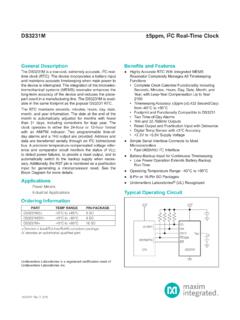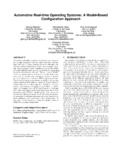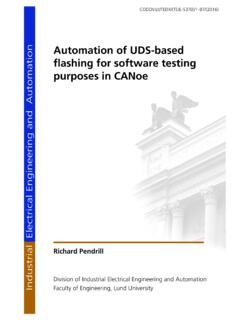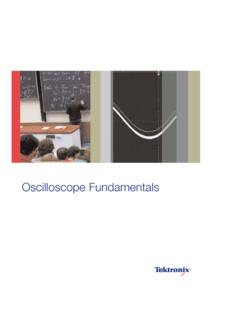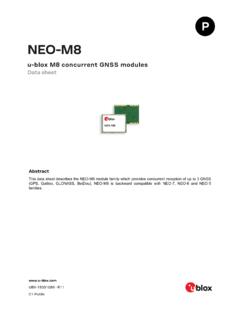Transcription of Introduction to the Controller Area Network (CAN) (Rev. B)
1 1 SLOA101B August2002 RevisedMay 2016 SubmitDocumentationFeedbackCopyright 2002 2016,TexasInstrumentsIncorporatedIntrodu ctionto the ControllerAreaNetwork (CAN) CANopenis a trademarkof CANin a trademarkof OpenDeviceNetVendorAssociation, August2002 RevisedMay 2016 Introductionto the ControllerAreaNetwork(CAN) controllerareanetwork (CAN) is ideallysuitedto the manyhigh-levelindustrialprotocolsembraci ngCANand ISO-11898:2003as cost,performance,and upgradeabilityprovidefortremendousflexib ilityin introductionto the CANfundamentals,operatingprinciples,and the implementationof a basicCANbus with TI's CANtransceiversand electricallayerrequirementsof a CANbus are discussedalongwith the importanceof thedifferentfeaturesof a TI Bit Fieldsof StandardCANand of Figures1 The LayeredISO InvertedLogicof a a a RecessiveBus of TablesDSPor ControllerApplication LayerData-LinkLayerLogic Link ControlMedium AccessControlPhysicalLayerPhysical SignalingPhysical Medium AttachmentMedium-Dependant InterfaceEmbeddedCANC ontrollerCANT ransceiverCAN Bus-LineElectricalSpecifications.
2 Transceivers,Connectors,CableCAN Controller ,Embedded August2002 RevisedMay 2016 SubmitDocumentationFeedbackCopyright 2002 2016,TexasInstrumentsIncorporatedIntrodu ctionto the ControllerAreaNetwork(CAN)(1)RobertBosch GmbH, CANbus was developedby BOSCH(1)as a multi-master,messagebroadcastsystemthat specifiesamaximumsignalingrate of 1 megabitper second(bps).Unlikea traditionalnetworksuchas USBorEthernet,CANdoesnot sendlargeblocksof datapoint-to-pointfromnodeA to nodeB underthesupervisionof a centralbus a CANnetwork,manyshortmessageslike temperatureor RPMare broadcastto the entirenetwork,whichprovidesfor dataconsistencyin everynodeof the messageformat,messageidentifiers,and bit-wisearbitration-- a majorbenefitof the CANsignalingschemeare explained,a CANbus implementationis examined,typicalwaveformspresented,and CANS tandardCANis an InternationalStandardizationOrganization (ISO)definedserialcommunicationsbus originallydevelopedfor the automotiveindustryto replacethe complexwiringharnesswith a two-wirebus.
3 Thespecificationcallsfor high immunityto electricalinterferenceand the abilityto self-diagnoseand to CAN s popularityin a varietyof industriesincludingbuildingautomation,me dical,and CANcommunicationsprotocol,ISO-11898:2003 ,describeshow informationis passedbetweendeviceson a networkand conformsto the OpenSystemsInterconnection(OSI)modelthat is definedintermsof the physicalmediumis definedbythe physicallayerof the ISO 11898architecturedefinesthe lowesttwo layersof the sevenlayerOSI/ISOmodelas the data-linklayerand physicallayerin The LayeredISO 11898 StandardArchitectureIn Figure1, the applicationlayerestablishesthe communicationlink to an upper-levelapplicationspecificprotocolsu chas the vendor-independentCANopen protocolis supportedby theinternationalusersand manufacturersgroup,CANin Automation(CiA).AdditionalCANinformation islocatedat the CiA Website, Manyprotocolsare dedicatedto particularapplicationslikeindustrialauto mation,dieselengines,or industry-standard,CAN-basedprotocolsare KVASER'sCANK ingdomand RockwellAutomation'sDeviceNet.
4 Bytes DataCCRRCCACKEOFEOFEOFFISIIDDEErr00 DDLLCC1 1- b itId e n tifie ExtendedCAN3 SLOA101B August2002 RevisedMay 2016 SubmitDocumentationFeedbackCopyright 2002 2016,TexasInstrumentsIncorporatedIntrodu ctionto the ControllerAreaNetwork (CAN) 3 StandardCANor ExtendedCANThe CANcommunicationprotocolis a carrier-sense,multiple-accessprotocolwit h collisiondetectionandarbitrationon messagepriority(CSMA/CD+AMP).CSMA meansthat eachnodeon a bus mustwait for aprescribedperiodof inactivitybeforeattemptingto senda +AMPmeansthat collisionsareresolvedthrougha bit-wisearbitration,basedon a preprogrammedpriorityof eachmessagein theidentifierfield of a higherpriorityidentifieralwayswinsbus , the last logic-high in the identifierkeepson transmittingbecauseit is the a bustakespart in writingeverybit "as it is beingwritten,"an arbitratingnodeknowsif it placedthe logic-highbiton the ISO-11898:2003 Standard,with the standard11-bitidentifier,providesfor signalingratesfrom125kbpsto 1 standardwas lateramendedwith the extended standard11-bitidentifierfield in Figure2 providesfor 211, or 2048differentmessageidentifiers,whereast he extended29-bit identifierin Figure3 providesfor 229, or 537 Bit Fieldsof StandardCANand StandardCAN:11-BitIdentifierThe meaningof the bit fieldsof Figure2 are.
5 SOF The singledominantstartof frame(SOF)bit marksthe startof a message,and is usedtosynchronizethe nodeson a bus afterbeingidle. Identifier-TheStandardCAN11-bitidentifie restablishesthe priorityof the lowerthebinaryvalue,the higherits priority. RTR The singleremotetransmissionrequest(RTR)bit is dominantwheninformationis nodesreceivethe request,but the identifierdeterminesthe also receivedby all nodesand usedby any this way,all databeingusedin a systemis uniform. IDE A dominantsingleidentifierextension(IDE)bi t meansthat a standardCANidentifierwith noextensionis beingtransmitted. r0 Reservedbit (for possibleuse by futurestandardamendment). DLC The 4-bitdatalengthcode(DLC)containsthe numberof bytesof databeingtransmitted. Data Up to 64 bits of applicationdatamay be transmitted. CRC The 16-bit(15 bits plus delimiter)cyclicredundancycheck(CRC)cont ainsthe checksum(numberof bits transmitted)of the precedingapplicationdatafor errordetection.
6 ACK Everynodereceivingan accuratemessageoverwritesthis recessivebit in the originalmessagewith a dominatebit, indicatingan error-freemessagehas receivingnodedetectanerrorand leavethis bit recessive,it discardsthe messageand the sendingnoderepeatsthe this way,eachnodeacknowledges(ACK)the integrityof its 2 bits,one is the acknowledgmentbit and the secondis a delimiter. EOF This end-of-frame(EOF),7-bitfield marksthe end of a CANframe(message)and disablesbit-stuffing,indicatinga bits of the samelogicleveloccurinsuccessionduringnor maloperation,a bit of the oppositelogiclevelisstuffedinto the data. IFS This 7-bitinterframespace(IFS)containsthe time requiredby the controllerto movea correctlyreceivedframeto its properpositionin a = 1 0 1R = 1 0 1 RecessiveRecessiveDominant110 VCANHVCANL1 1- bi tIde nti fi erRTRIDEr 0D L C0 ..8C R CA C Kr 11 8 -bi tIde n tif ierSRRSOFB ytes DataEOFEOFEOFFISA August2002 RevisedMay 2016 SubmitDocumentationFeedbackCopyright 2002 2016,TexasInstrumentsIncorporatedIntrodu ctionto the ControllerAreaNetwork(CAN) ExtendedCAN:29-BitIdentifierAs shownin Figure3, the ExtendedCANmessageis the sameas the Standardmessagewith theadditionof: SRR The substituteremoterequest(SRR)bit replacesthe RTRbit in the standardmessagelocationas a placeholderin the extendedformat.
7 IDE A recessivebit in the identifierextension(IDE)indicatesthat moreidentifierbits 18-bitextensionfollowsIDE. r1 Followingthe RTRand r0 bits, an additionalreservebit has beenincludedaheadof the fundamentalCANcharacteristicshownin Figure4 is the oppositelogicstatebetweenthe bus, and thedriverinputand ,a logic-highis associatedwith a one,and a logic-lowisassociatedwith a zero- but not so on a CANbus. This is why TI CANtransceivershavethe driverinputand receiveroutputpins passivelypulledhigh internally,so that in the absenceof any input,the deviceautomaticallydefaultsto a recessivebus stateon all inputand The InvertedLogicof a CANBusBus accessis event-drivenand two nodestry to occupythe bus simultaneously,accessis implementedwith a nondestructive, the nodewinningarbitrationjust continueson with the message,withoutthe messagebeingdestroyedor corruptedby allocationof priorityto messagesin the identifieris a featureof CANthat makesit particularlyattractivefor use withina lowerthe binarymessageidentifiernumber,the higherits identifierconsistingentirelyof zerosis the highestprioritymessageon a networkbecauseit holdsthe bus dominantthe ,if two nodesbeginto transmitsimultaneously,the nodethat sendsa last identifierbit as a zero(dominant)whilethe othernodessenda one (recessive)
8 Retainscontrolof the CANbus and goeson to completeits dominantbit alwaysoverwritesarecessivebit on a BusNode CTransmitsNode BTransmitsC winsarbitrationB CANM essage5 SLOA101B August2002 RevisedMay 2016 SubmitDocumentationFeedbackCopyright 2002 2016,TexasInstrumentsIncorporatedIntrodu ctionto the ControllerAreaNetwork (CAN) Notethat a transmittingnodeconstantlymonitorseachbi t of its own is the reasonforthe transceiverconfigurationof Figure4 in whichthe CANHand CANL outputpins of the driverareinternallytied to the receiver' propagationdelayof a signalin the internalloop fromthe driverinputto the receiveroutputis typicallyusedas a qualitativemeasureof a referredto as the loop time (tLOOPin a TI datasheet),but takeson variednomenclaturefromvendorto displaysthe CANarbitrationprocessthat is handledautomaticallyby a own transmissions,as nodeB's recessivebit is overwrittenby nodeC s higherprioritydominantbit, B detectsthat the bus statedoesnot matchthe bit that it ,nodeB haltstransmissionwhilenodeC continueson with its messageis madeby nodeB oncethe bus is releasedby nodeC.
9 This functionalityis part ofthe ISO 11898physicalsignalinglayer,whichmeansth at it is containedentirelywithinthe CANcontrollerand is completelytransparentto a Arbitrationon a CANBusThe allocationof messagepriorityis up to a systemdesigner,but industrygroupsmutuallyagreeon thesignificanceof example,a manufacturerof motordrivesmay specifythat message0010is a windingcurrentfeedbacksignalfroma motoron a CANnetworkand that 0011is the lowestbinaryidentifier,messagesrelatingt o currentvaluesalwayshavea higherpriorityon the bus thanthoseconcernedwith the caseof DeviceNet , devicesfrommanymanufacturerssuchas proximityswitchesandtemperaturesensorsca n be incorporatedinto the messagesgeneratedbyDeviceNetsensorshaveb eenpredefinedby theirprofessionalassociation,the OpenDeviceNetVendorsAssociation(ODVA),a certainmessagealwaysrelatesto the specifictype of sensorsuchas temperature,regardlessof the four differentmessagetypes,or frames(seeFigure2 and Figure3), that can be transmittedon aCANbus are the dataframe,the remoteframe,the errorframe,and the August2002 RevisedMay 2016 SubmitDocumentationFeedbackCopyright 2002 2016,TexasInstrumentsIncorporatedIntrodu ctionto the ControllerAreaNetwork(CAN) DataFrameThe dataframeis the mostcommonmessagetype,and comprisesthe ArbitrationField,the DataField,the CRCF ield,and the ArbitrationFieldcontainsan 11-bitidentifierinFigure2 and the RTRbit, whichis dominantfor Figure3, it containsthe 29-bitidentifierand the RTRbit.
10 Nextis the DataFieldwhichcontainszeroto eightbytesof data,and the CRCF ieldwhichcontainsthe 16-bitchecksumusedfor is the RemoteFrameThe intendedpurposeof the remoteframeis to solicitthe transmissionof similarto the dataframe,with two ,this type of messageisexplicitlymarkedas a remoteframeby a recessiveRTRbit in the arbitrationfield,and secondly,thereisno ErrorFrameThe errorframeis a specialmessagethat violatesthe formattingrulesof a is transmittedwhena nodedetectsan errorin a message,and causesall othernodesin the networkto sendan errorframeas originaltransmitterthenautomaticallyretr ansmitsthe elaboratesystemoferrorcountersin the CANcontrollerensuresthat a nodecannottie up a bus by OverloadFrameThe overloadframeis mentionedfor is similarto the errorframewith regardto theformat,and it is transmittedby a nodethat becomestoo is primarilyusedto providefor an ValidFrameA messageis consideredto be errorfree whenthe last bit of the endingEOFfield of a messageisreceivedin the dominantbit in the EOFfield causesthe transmitterto repeata FaultConfinementThe robustnessof CANmay be attributedin part to its CANprotocolincorporatesfive methodsof errorchecking:threeat the messageleveland two at the bit messagefails any one of theseerrordetectionmethods,it is not acceptedand an errorframeisgeneratedfromthe forcesthe transmittingnodeto resendthe messageuntil it ,if a faultynodehangsup a bus by continuouslyrepeatingan error,itstransmitcapabilityis removedby its controllerafteran errorlimit is the messagelevelis enforcedby the CRCand the ACKslotsdisplayedin Figure2 andFigure3.










